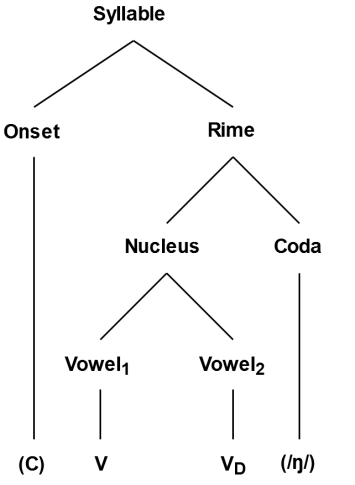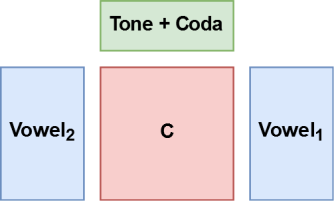We cannot understand if we do not first learn the language and grasp the symbols in which it is written.
―
Toaq’s writing system is an abugida. It groups syllables together as units composed of a primary consonant glyph and secondary vowel glyphs and a tone mark. The arrangement is closely linked to Toaq’s syllable structure, so to understand the script, one should first have a basic understanding of Toaq’s syllables in general.
In the following diagram, C is any consonant phoneme other than /ŋ/, V is any individual vowel, VD is any diphthong from among /ai/, /ao/, /oi/, /ei/ or any individual vowel. Items surrounded by brackets are optional.

This structure is mirrored in the script.
The consonant-vowel unit
Each syllable is arranged as follows:

At the center of the syllable is the onset consonant C. It is surrounded by the vowels and the tone mark. Vowel1 is placed on the right and Vowel2 is placed on the left.
Vowel1 is any individual vowel from among /a/, /u/, /i/, /o/, /e/.
Vowel2 is either one of the diphthongs /ai/, /ao/, /oi/, /ei/, or one of the vowels of Vowel1.
Important: At least one of the vowel positions must be occupied. If the nucleus contains one of the four diphthongs mentioned above, then Vowel1 can be empty, otherwise it must be occupied. In that case, Vowel2 can be empty.
We will first look at the consonant glyphs, then the vowels, and finally the tone marks.
Consonants
These are the 17 initial consonants of Toaq:
| Phoneme | Glyph | Phoneme | Glyph |
|---|---|---|---|
| /m/ |  |
/r/ |  |
| /p/ |  |
/l/ |  |
| /b/ |  |
/tɕ/ |  |
| /f/ |  |
/dʑ/ |  |
| /n/ |  |
/ɕ/ |  |
| /t/ |  |
/k/ |  |
| /d/ |  |
/g/ |  |
| /ts/ |  |
/h/ |  |
| /s/ |  |
NULL * |  |
* This glyph marks the empty onset. An empty onset is generally realized as /ʔ/ (glottal stop).
The phoneme /ŋ/ cannot appear in onset position and is therefore listed in a later section.
Vowels

Each vowel has two forms: one as the first vowel of a syllable (Vowel1), and one as the second vowel of a syllable (Vowel2). The four diphthongs (VD) can only appear in Vowel2 and therefore only have one form. Vowel1 is placed to the right of the consonant, while Vowel2 is placed on the left.
| Phoneme | Vowel2 | Consonant | Vowel1 |
|---|---|---|---|
| /a/ * |  |
 |
 |
| /u/ |  |
 |
 |
| /i/ |  |
 |
 |
| /o/ |  |
 |
 |
| /e/ |  |
 |
 |
| /ai/ |  |
 |
/ |
| /ao/ |  |
 |
/ |
| /oi/ |  |
 |
/ |
| /ei/ |  |
 |
/ |
| NULL ** | / |  |
/ |
* /a/ is implied in Vowel1 if no explicit vowels are present. Because of this, the Vowel1 character for /a/ is not required and usually omitted.
** An underdot can be placed under a consonant to indicate the lack of any vowel. This is most commonly used for Toaq’s m-interjections, but can also be used to transcribe foreign words.
Examples
We can now create our first simple syllables. Here are some examples:

In order, these read: na ke laı nuo tıao
Tone and Coda

The third and final component (green) marks the tone of the syllable and indicates whether the syllable is open or closed, i.e., whether its coda is occupied by /ŋ/ or not.
Tone + Coda is encoded by a single compound diacritic. Since every Toaq syllable carries one of 7 tones or is toneless, and is either open or closed, there are 16 possible combinations for the Tone + Coda slot. They are as follows:
| Open (empty coda) | Closed (coda /ŋ/) | |
|---|---|---|
| Neutral tone |
 |
 |
| Flat tone |
 |
 |
| Rising tone |
 |
 |
| Rising glottal tone |
 |
 |
| Falling tone |
 |
 |
| Rising-falling tone |
 |
 |
| Low tone |
 |
 |
| Low glottal tone |
 |
 |
Examples

These read: bũ mẻo kảqsī níchāq kùı

These read: m̉ arānē ào élū
And that’s all there is to know.
The most recent version of the font can be downloaded from toaq.org/font/TS_current.ttf.

Couldn’t the circle for null-onset be eliminated if you placed the tone/coda mark over the vowel-1 symbol? I think this would also give the vowel-1 symbol for /a/ an actual reason to exist.
LikeLike
The article does not mention this, but an important property of the script is that it is unambiguous even in spaceless writing. What you suggest would be problematic in that regard, because there would be no way in, say, “KE” to distinguish “ka e” from “ke” if the E doesn’t have a tone mark. This may or may not have any actual consequences, depending on whether we allow neutral tone vowel-initial words (i.e., function words) (current thinking is that we probably shouldn’t), but just the theoretical ambiguity (or the need to use some kind of disambiguating symbol just in that situation) puts the elegance of such an approach into question for me. And even if vowel-initial function words are disallowed, word/syllable boundary problems still crop up when transcribing foreign words. I find it simpler to just say that tone marks go on consonants and that the circle is pronounced as a glottal stop. Also, omitting the circle might invite people to get sloppy and forget to pronounce the glottal stop. Lastly, it would break symmetry by introducing a special rule for these syllables.
LikeLike
Your second sentence seems a bit garbled, but I think I was able to piece together what you meant in the context of spaceless writing. Yes, you’d have to use a hyphen or something in such a case, which wouldn’t be pretty. Your other points carry weight. In my own unpublished conlang, the glottal stop is a full-fledged consonant written with the apostrophe (I only have a Latin script).
LikeLike
Oh whoops. I put some text in angle brackets and it disappeared. It should be understandable now.
LikeLike